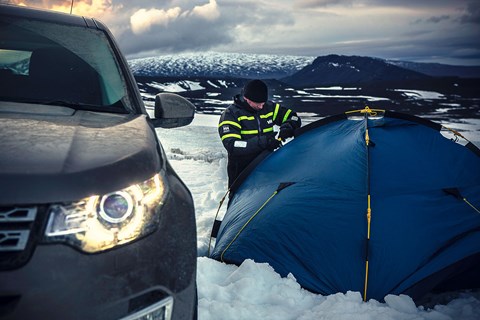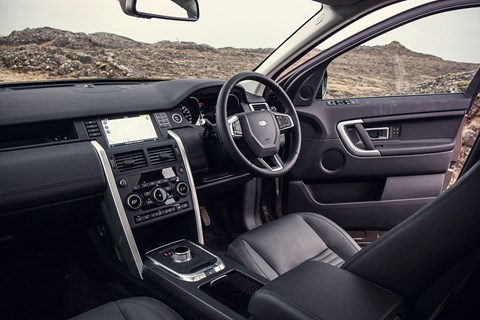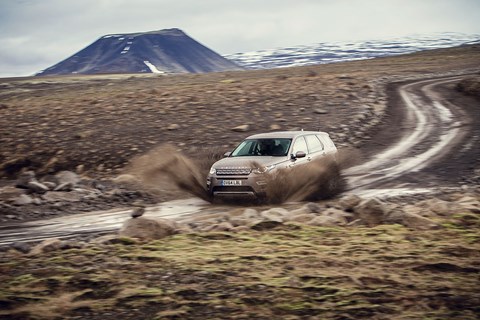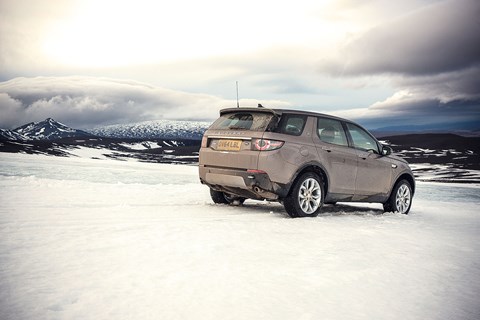► A camping expedition with a difference
► Mark Walton under canvas on a glacier
► Rugged initiation for new Land Rover Discovery Sport
The wind whistles and moans around the tent, and the fabric flaps like a torn Tesco bag in a hurricane. It’s making such a racket I can’t sleep. I switch on my head torch. The white beam picks out tiny ice crystals in the blackness, blown in through the vents and gently raining down on my sleeping bag. It’s a bit creepy. Despite all the shaking, slapping and flapping, there’s a kind of eerie, background silence outside, an emptiness that your senses detect beneath the wind. There isn’t another living thing on this glacier tonight – not a bird nor an insect; no rabbits, mice, polar bears or Arctic foxes. No Yeti, as far as I know. I turn off the torch and pull the sleeping bag tight around my woolly hat. For the thousandth time, my mind runs through the Emergency Evacuation Plan.
It’s unlikely the tent will be blown away. Not entirely, anyway. I brought some rocks up with me from the lava field below, six boulders the size and weight of bowling balls, and stuck them into the corners of my ground sheet. So, chances are, if the wind gets any worse there’ll be a sudden ripping sound, and the tent’s upper half will peel up-up-and-away, like a kite escaping a snapped line. Leaving me lying out in the open, like a solitary sardine on a supermarket fish counter.
In that case, my only option would be the car.
Yes, the car, parked right there, outside my tent. You know that feeling, when you go on a long winter walk and get caught out by the weather? That sense of relief, when you get back in the car, all soggy and cold, and close the door? Well, compared to my dark little dome, the Land Rover’s interior would be like a pristine, high-tech escape pod if I climbed in there now – warm and dry and glowing with light, completely impervious to the 70mph winds and the -20 degree windchill. With the rear seats folded flat, there’s even a six-foot bed in the back, and a panoramic glass roof – I could lie there and look up, waiting for the Northern Lights! I fall into a fitful sleep, thinking (with a sob): ‘Right now, that Land Rover’s the only friend I’ve got.’

Land Rovers are like that though, aren’t they? A cross between a battle tank and a faithful black labrador called Miffy. Years ago, I had a Defender 110. Nightmare to park, with the turning circle of a holiday coach, but every day, climbing up into that cabin made me feel like a North Sea trawlerman, heading out into a storm, ready for anything.
I had a Discovery 3 for a while too, drove it from London to Timbuktu for this magazine, as some readers might recall. Over sandy deserts, rutted tracks and floods, it was my go-anywhere sanctuary, inspiring the kind of ‘buddy’ emotions normally reserved for a horse. As Roy Rogers once sang to Trigger, ‘A four-legged friend, a four-legged friend, he’ll never let you down.’
I don’t think modern Range Rovers inspire these feelings. Sure, they’re tough, but they’re a bit too haughty and regal to love like a faithful dog. It’s the beaten-up old Defender that you adopt as part of the family.
Which brings us to the new generation of Land Rover. The new Disco Sport has the dimensions of a Freelander, the seven seats of a Discovery 4, and the swept-back sleekness of a Range Rover Sport. But what about its character? To really get to know it, we need to take the new Sport on an adventure, and I mean a proper expedition, the kind that would have Bear Grylls checking into a hotel. We need to go on a journey into the wilderness, enduring cold, discomfort and hardship, and not to test the four-wheel drive. Boring! No, I want to find out, if the new Disco Sport died, would I bury it at the bottom of the garden under a little headstone? Or would I stick it in a black sack and drop it in the wheelie bin? Fundamental questions. It’s time someone answered them.
Click here to check out used Land Rovers for sale in our Cars For Sale section.
Our madcap camping expedition in a Discovery Sport
What a strange, bleak, haunted place Iceland seems, when you first drop out of the clouds to land at Keflavik airport. You look down on a landscape of black rock and drizzle, and by the time we’re leaving the terminal, it’s already getting dark. In the winter, Iceland’s gloomy dusk arrives by mid-afternoon, and you don’t see proper daylight again for nearly 18 hours. Depressing? Apparently, Iceland has a relatively low incidence of seasonal suicide, and it’s not genetic – they think it’s the fishy diet. Captain Birdseye does seem quite cheerful, come to think of it.
Anyway, thankfully there’s enough light left for us to check out the new Discovery, waiting for us in the car park. It’s in HSE trim with a 2.2 SD4 turbodiesel (the only engine available at launch), finished in ‘Kaikoura Stone’ (metallic beige) with 19-inch alloys. Having seen the Sport on the Paris show stand, even I have to begrudgingly admit it looks good out here in the real world. Begrudging, because I prefer my Land Rovers blunt and basic like a loaf of brown bread; the Sport is so pumped full of those posh Range Rover genes, they could’ve easily badged it a ‘Grand Evoque’. But I can’t deny, I like its aggressive poise and muscular arches, and the high waistline makes it look like it could wade through deep lava. Which might come in useful here.
Open the door, and the interior has a clean, linear structure – nothing remarkable, after years of seeing modern Range Rovers, just a bit more vertical than an Evoque. You might look at the pictures and think *shrug*, but what the photos can’t convey is the quality: it is beautifully finished, with tactile materials, lovely rotary dials, and black leather trim with ribbed stitching. Land Rover has also fitted our test car with wall-to-wall rubber mats, that look like you could hose them down with a farmyard jet wash. Nice contrast. Now let’s get out there and find some mud.

Iceland only has a couple of dual carriageways, and one of them runs from the airport into Reykjavik. As we head down it, I realise there’s only so much I’ll be able to tell you about the car’s handling on this trip – it’s on studded tyres, and as well as making a constant fizzing sound, the titanium spikes take some of the bite out of the steering and brake feel. Still, there are some first impressions I can share with you: the 187bhp engine and nine-speed automatic gearbox are strong, smooth and slick, the car rides well, and I like the size. It’s not like driving a gigantic Chelsea tractor, like, er… you know… a Range Rover. The new Sport is about 10cm longer than the outgoing Freelander 2, but a few millimetres narrower and lower too. Inside it’s roomy but it’s also intimate, like you’re driving a normal family car rather than a vast four-wheel-drive barge. The back seats slide on a rail, so you can push the middle bench back for proper limo-style passenger legroom, and there’s the fold-out third row of course, though on this trip seat #6 and #7 are redundant and trapped under a rubber mat, like a ventriloquist’s dummy shouting, ‘Let me out of the box!’
We bypass the capital and head out towards Iceland’s interior, known as ‘the Highlands’. By now it’s pitch black, and we’ve turned off the tarmac onto a gravel road. It feels like we’ve left all humanity behind: there are no lights out here, no houses, just a single-lane track across a rocky plain. Rock is a common theme here – if you think lava sets flat and solid like concrete, think again. Sticky lava cools and breaks as it slowly rolls out, leaving a vast, jumbled carpet of black rubble called ‘clinker’. Impossible to walk over, it looks eerie, unforgiving and desolate in the margins of our Xenon lights.
Off-roading in the Disco Sport
Thankfully, the 4×4 Disco feels completely at home on this kind of road. Loose and uneven, the track could be dangerous if you got swervy, but the Land Rover just blitzes it, tracking straight and inspiring confidence. We fly along at 50mph, not another car in sight.
That night we stay in the Hotel Ion, near the Nesjavallavirkjun geothermal plant. It looks like a factory, but it’s actually sucking hot water up from deep underground and piping it into Reykjavik’s communal heating system, about 50 miles away. The whole area is steaming and sulphurous, and we drive past several silver domes with huge taps outside, humming with pressure and hot to touch. Finding dinosaur eggs here would not come as a surprise.
Next morning we drive north on an asphalt road, past Thingvellir, site of the nation’s first parliament back in 930AD, then we turn off to enter another gravel track. This is the Kaldidalur road, literally ‘cold valley’, and it’s one of three routes that cross the island’s empty interior. Once on it, there are no signposts, just a warning that the road is ‘impassable’.
At first the surface is a coarse gravel, graded and smooth, and we make good progress, flying alongside semi-frozen lakes with a plume of dust at our tail. But the black rock turns brown, and the road deteriorates until we’re up to our necks in thick, chocolatey mud. In a regular car this would mean ‘game over’, but it’s classic Land Rover territory, and nothing worse than I’ve seen in Yorkshire. The Discovery Sport duly shows its class.
Under the skin, the Sport is basically an Evoque, with the same engine, transmission and Haldex centre coupling, controlled by the same Terrain Response system. Borrowing a few tried and tested parts is no bad thing though, when you’re Land Rover. Unlike the newer Range Rovers, there is no ‘Auto’ setting for the Terrain Response, so I press the button on the dash to engage the ‘Muddy Ruts’ setting (perfect for these, um, muddy ruts). The throttle response feels different straight away, and the tightness of the traction control. We wallow and squirm our way, until we’ve painted every panel a new shade of ‘Icelandic Beige’.

Eventually the mud disappears as we climb higher, and we cross more giant lava plains – older ones now, softened with green moss and speckled with snow. A few days earlier it was white up here, apparently, and while the snow has mostly gone, the photos might be a little misleading – it is bitingly, balls-off-a-brass-monkey cold, with a wind that cuts you through to your bones.
We reach a cairn, marking the highest point on the road, about 750 metres above sea level. From here we can see the glaciers, with that strange blue snow that looks lit up from the inside. We’re heading up to the second biggest glacier in Iceland, the Langjökull or ‘long glacier’, which is about 31 miles long and 12 miles across. A little further up the road we turn off, up a minor track that climbs the valley side, higher and higher, until we meet a gigantic white ice field. Seen from this angle, this is not your archetypal TV documentary glacier – no cliff face full of crevasses, no ‘calving’ into the sea, no David Attenborough. Instead, it’s a steady, steep slope of frozen snow, that heads up and up, filling the windscreen to the horizon high above us. This is no winter wonderland; no-one is sledging, and there are no elves making toys. It just looks big, intimidating and dead.
We pass a hut and a huge, eight-wheel-drive tourist truck – some enterprising locals are building an ice cave higher up, drilling 300 metres into the ice. They plan to take tourists up there, when it opens next year. The drilling means there’s been a fair bit of traffic up this slope, and the transition from rock to ice has been pounded and refrozen into a kind of mashed-potato slush. There’s even a SuperJeep stuck in it. SuperJeeps are Iceland’s crazy off-roaders with monster wheels and tyres, that can be deflated to cross the interior in winter. We’ve met up with local guide Ingolfur Stephansson, or ‘Ingo’, with his ‘big foot’ Defender, in case we get stuck, but his first job is to winch another truck out of the crusty slush. And then it’s my turn to cross over onto the ice. Suddenly those studded tyres feel like a puny gesture.
Truthfully? It was never going to work. As soon as my front wheels hit the slush, I’m up to my axles in ice cubes. I get out of the car to attach the tow rope as Ingo deflates his tyres, ready to pull me out. The wind is just unreal – like nothing I’ve ever encountered. It’s blowing straight off the glacier at what feels like 60 or 70 miles an hour, hard enough to literally blow you off your feet, and after five minutes fiddling with the tow rope the windchill feels like frosty knitting needles, jabbing you relentlessly in the face. And they want to bring tourists up here?

Ingo’s Defender gives me a few sharp tugs and the nose of the Discovery is yanked up and out. I manually click down to the very low first gear, and find I can make forward progresss if I can just keep moving. Counter-intuitively, we’ve got the Terrain Response in sand mode, as it configures the system to avoid sinking. Eventually we stop to undo the tow rope, but with a bit of practise I get the Disco going again under its own steam. There’s a knack to it – you have to roll the car back and forth an inch or two, avoiding wheelspin at all costs, to crush a little path. That’s all you need to get a tiny run-up, enough to get moving over the surface. It helps that the Sport is relatively light – with aluminium wings, bonnet, roof and tailgate, it’s 700kg lighter than the standard Disco 4, which probably would have sunk into the ice and disappeared like a dead mammoth.
Finally, we get the Discovery parked a few hundred metres up the slope. In the lee side we dig a shallow base for the tent, though the snow hole isn’t as deep as I’d hoped – dig 30cm down and you come to a bed of ice as hard as iron. Next, erecting the tent in the fast fading light – it’s comical, like trying to hang the washing out in a tornado. Fabric smashed in my face and poles bending, eventually we get it pegged out, pinned down and lashed to the steadfast car. As I use our shovels as two last industrial-strength tent pegs, the workers from the ice cave drive past, heading home in their tracked Snowcat vehicle. They look at me, bewildered. I stare back, forlorn. And then it’s dark.
Photographer Charlie Magee and Ingo head down off the glacier, to drive to a small B&B about 40 minutes away. I fold down the back seats and eat a last dry sandwich in the back of the Land Rover, before turning in to bed. And as I fall into a fitful sleep, I think (with a sob): ‘Right now, that Land Rover’s the only friend I’ve got.’
Which means the new Discovery Sport passes the test. Welcome to the family.
If you enjoyed this feature from the January 2015 issue of CAR magazine, check out our preview of the latest issue here. The best way to make sure you never miss an issue is to subscribe – click here for our best deals in print and digital editions.
Click here to check out used Land Rovers for sale in our Cars For Sale section.